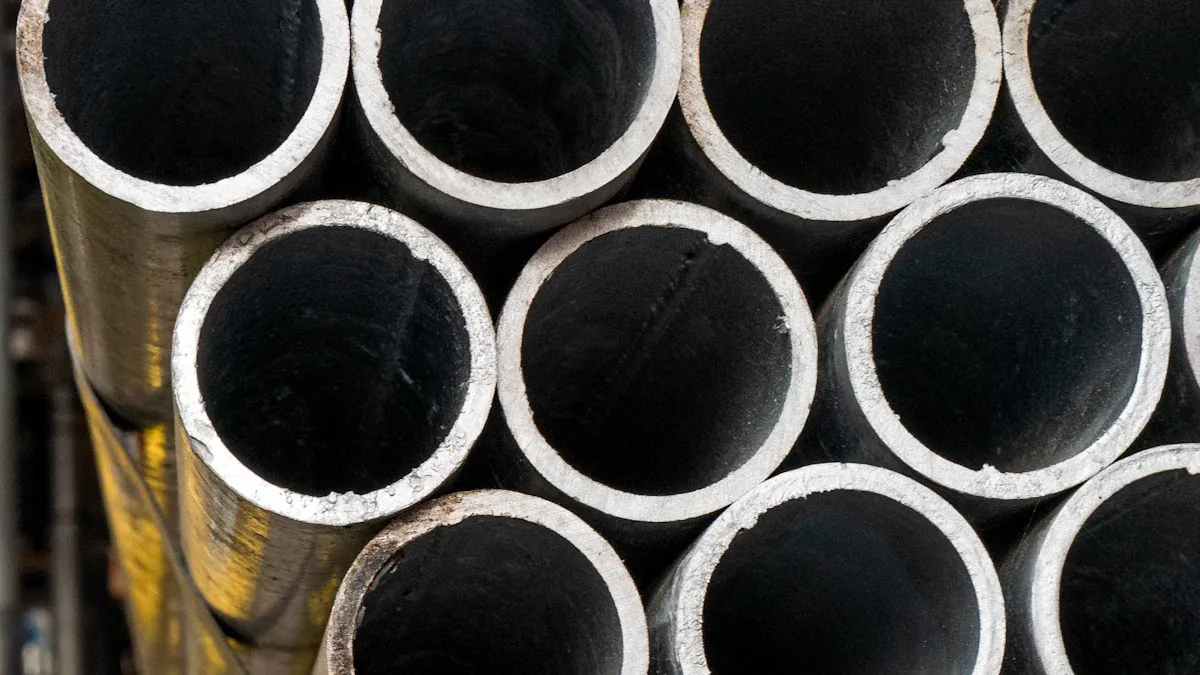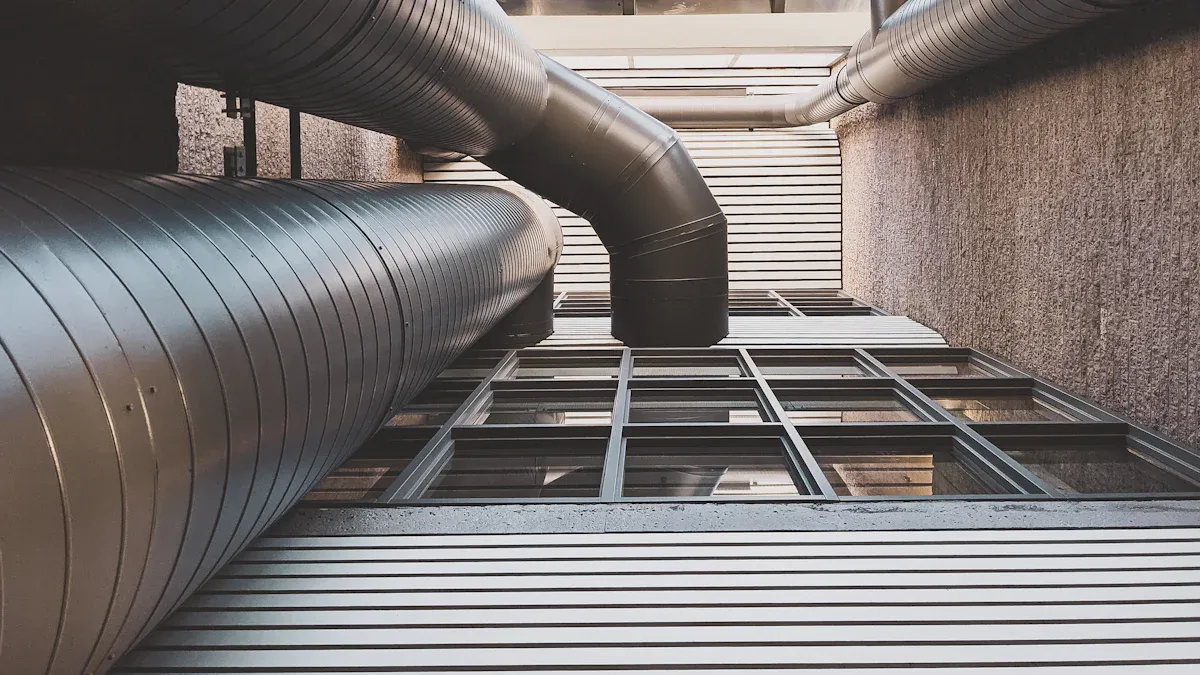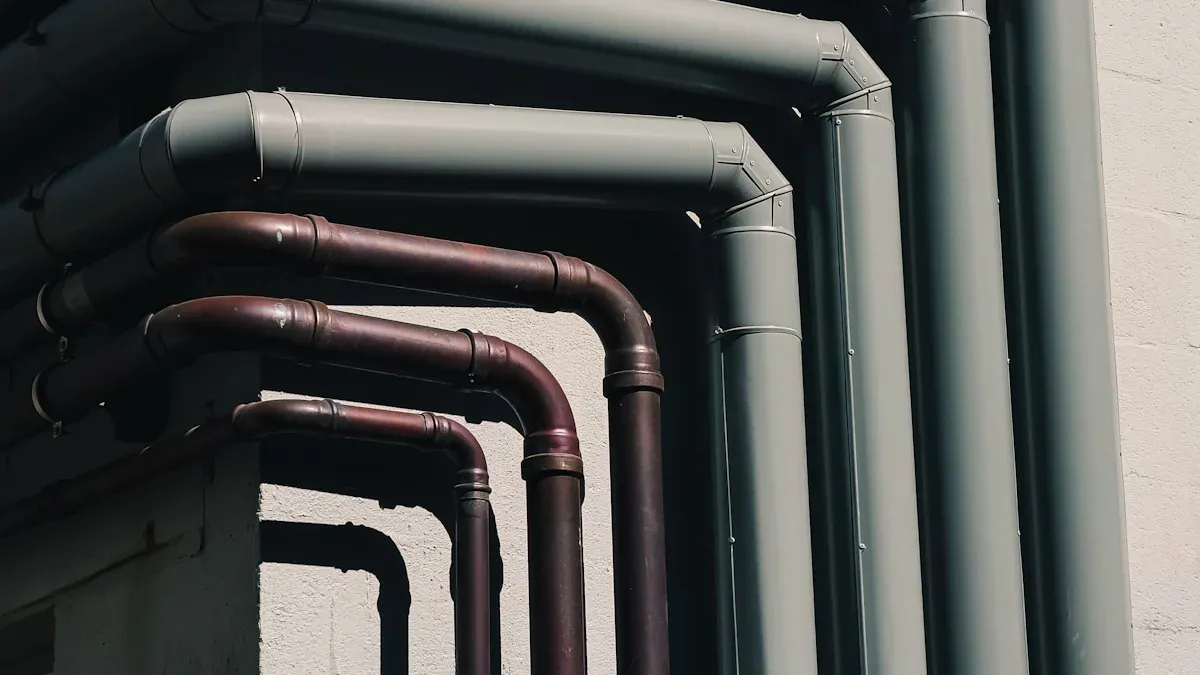High Temperature Polyimide Tubing: How to Choose Right

Choosing the right high temperature polyimide tubing directly impacts the performance and safety of your application. This specialized tubing offers exceptional heat resistance, making it ideal for demanding environments. Seamless polyimide tubes deliver superior performance, while spiral-wound options provide cost-effective solutions for specific uses. Materials like PTFE and polyurethane balance durability and cost, reducing replacement needs. High temperature polyimide tubing also meets strict standards in industries like medical and aerospace, ensuring reliability. By understanding your requirements, you can select tubing that optimizes both performance and budget.
Key Takeaways
Pick high-temperature polyimide tubing that can handle high heat.
Measure the inside and outside sizes carefully to avoid mistakes.
Check if the tubing is strong and bends well for your needs.
Think about spending more now to save on repairs later.
Make sure the tubing follows rules for safety in different industries.
Understanding Temperature Resistance in Polyimide Tubing

Why Temperature Resistance is Critical
Polyimide tubing stands out among high-temperature plastics due to its exceptional ability to withstand extreme heat. This property ensures reliable performance in demanding environments. You will find that temperature resistance is vital for maintaining the structural integrity of the tubing. Without it, the material may degrade, leading to failures in critical applications.
Key benefits of temperature-resistant polyimide tubing include:
Excellent thermal stability, even at high operating temperatures.
Chemical inertness, which prevents reactions with harsh substances.
Flexibility and biocompatibility, especially in medical applications.
These qualities make polyimide tubing a preferred choice for industries like aerospace, electronics, and healthcare.
Evaluating Temperature Tolerance for Your Application
When selecting polyimide tubing, you must assess its operating temperature range. This ensures the tubing can handle the conditions of your specific application. Measurement standards, such as Maximum Service Temperature and Relative Thermal Index (RTI), help determine the material's suitability.
Measurement Standard | Description |
|---|---|
Maximum Service Temperature | The highest temperature a material can endure without losing properties, as per EN 14706:2005. |
Continuous Use Temperature | The temperature for long-term operation without degradation, determined by RTI and Vicat softening tests. |
Relative Thermal Index (RTI) | A measure indicating the temperature for 100,000 hours of aging while retaining at least half of its properties. |
By understanding these standards, you can confidently choose tubing that meets your application's requirements.
Typical Temperature Ranges for High-Temperature Polyimide Tubing
High-temperature plastics like polyimide tubing exhibit impressive heat resistance. For example, shape memory polyimides have a glass transition temperature (Tg) ranging from 182°C to 295°C. This range highlights their ability to perform under extreme conditions.
Additionally, research shows variations in temperature resistance based on material composition.
Material Type | T5 (°C) | T10 (°C) | Char Yield (%) at 800°C |
|---|---|---|---|
Parent Polyimide (BMDA) | 540 | 572 | 62 |
BMDA-Al2O3-9% | 548 | 578 | N/A |
BMDA-ZnO-9% | 462 | 513 | N/A |
These figures demonstrate how different formulations of polyimide tubing can meet diverse application needs. Selecting the right material ensures optimal performance at high operating temperatures.
Selecting the Right Size and Dimensions
Measuring Inner and Outer Diameter Accurately
Accurate measurements of inner diameter (ID) and outer diameter (OD) are essential when selecting polyimide tubing. These dimensions directly affect the tubing's performance, especially in high-temperature applications. You can use established design standards to ensure that specifications for ID, OD, and wall thickness are clearly communicated to manufacturers. This minimizes errors during production.
Advanced methodologies, such as Monte Carlo simulations, help analyze the impact of dimensional variations on tubing performance. These simulations provide realistic assessments of tolerances, ensuring the tubing meets your application's requirements. Additionally, specifying achievable tolerances and implementing inspections, like pressure testing, can eliminate defective parts.
Wall Thickness and Its Impact on Performance
Wall thickness plays a critical role in determining the durability and efficiency of polyimide tubing. Thicker walls enhance mechanical strength, making the tubing suitable for high-pressure environments. However, they may reduce flexibility, which could limit the tubing's application in certain scenarios.
The relationship between tubing dimensions and operational performance is well-documented. For instance, parameters like the Heat Transfer Coefficient (HTC) and Pressure Drop (PD) are influenced by wall thickness. A thinner wall may improve heat transfer rates but could compromise structural integrity.
Parameter | Description |
|---|---|
Heat Transfer Coefficient (HTC) | A critical measure of efficiency influenced by tubing dimensions, affecting heat transfer rates. |
Pressure Drop (PD) | Another key efficiency measure, impacted by the design and dimensions of the tubing. |
Nusselt Number | Used to evaluate the convective heat transfer performance in relation to the tubing dimensions. |
Understanding these factors helps you balance performance and durability when choosing tubing for specific operating temperatures.
Ensuring a Proper Fit for Complex Applications
In complex applications, ensuring a proper fit is crucial. Tubing that fits poorly can lead to inefficiencies or even system failures. Case studies highlight the importance of considering environmental conditions, operating temperature, and pressure requirements when selecting tubing. For example, in medical applications, tubing must comply with FDA regulations to ensure safety and suitability.
Industry standards, such as those from the American Petroleum Institute (API) and the International Organization for Standardization (ISO), provide guidelines for material selection. These standards emphasize the need for tubing to withstand chemical exposure and mechanical stress. By adhering to these criteria, you can ensure the tubing performs reliably in demanding environments.
Assessing Durability and Performance

Mechanical Strength and Flexibility
When choosing polyimide tubing, you need to evaluate its mechanical strength and flexibility. These properties determine how well the tubing can withstand physical stress and adapt to different shapes without breaking. Polyimide materials are known for their exceptional strength, which makes them suitable for demanding applications. Research on polyimide/3D graphene composite films shows that adding three-dimensional graphene significantly improves the mechanical properties of polyimide. This enhancement ensures the tubing remains durable and flexible, even under challenging conditions.
Flexibility is especially important in applications requiring frequent movement or bending. For example, in medical devices, tubing must maintain its integrity while being maneuvered through tight spaces. By selecting tubing with the right balance of strength and flexibility, you can ensure reliable performance in your application.
Chemical Resistance and Environmental Factors
Polyimide tubing offers excellent chemical resistance, making it ideal for environments with exposure to harsh substances. It resists degradation when in contact with acids, bases, and solvents, ensuring long-term reliability. This resistance is crucial in industries like aerospace and electronics, where tubing often encounters extreme conditions.
Environmental factors, such as humidity and UV exposure, can also impact tubing performance. Polyimide materials are designed to withstand these challenges, maintaining their properties over time. When selecting tubing, consider the specific environmental conditions of your application. This ensures the tubing performs effectively, even in the most demanding settings.
Longevity and Maintenance Considerations
The longevity of polyimide tubing depends on its ability to maintain performance over time. High-temperature polyimide tubing can operate at temperatures up to 400 °C, making it suitable for long-term use in high-heat environments. Advanced surface deactivation techniques further enhance its lifespan by reducing wear and tear.
Feature | Description |
|---|---|
Maximum Operating Temperature | Up to 400 °C |
Material | High-temperature polyimide |
Robustness | Advanced surface deactivation for improved lifetime |
Performance | Low bleed performance at high temperatures |
Proper maintenance also plays a role in extending the life of the tubing. Regular inspections and cleaning can prevent issues like blockages or material degradation. By prioritizing longevity and maintenance, you can reduce replacement costs and ensure consistent performance.
Ensuring Application Compatibility
Matching Tubing Properties to Industry Requirements
High-temperature polyimide tubing must align with the specific needs of your industry. Each sector has unique requirements that dictate the tubing's properties. For instance, aerospace applications demand materials that can endure extreme heat and mechanical stress. Electronics often require tubing with excellent electrical insulation and flexibility. Medical applications prioritize biocompatibility and precision.
To ensure compatibility, you should evaluate the tubing's thermal stability, chemical resistance, and mechanical strength. Industry standards, such as ISO certifications, provide benchmarks for these properties. By matching the tubing's specifications to your industry's requirements, you can achieve optimal performance and safety.
Common Applications: Medical, Aerospace, and Electronics
Polyimide tubing serves critical roles across various industries. Its versatility and high-performance characteristics make it indispensable in demanding environments. The table below highlights its usage in medical, aerospace, and electronics sectors:
Industry | Usage Characteristics | Demand Variability |
|---|---|---|
Aerospace | Utilized in engine component insulation and radar waveguide systems. | Fluctuates with aircraft production cycles. |
Electronics | Used in flexible printed circuit boards and semiconductor packaging. | Monthly consumption variance exceeds 40%. |
Medical | Limited use in orthopedic implant coatings, constrained by qualification processes. | Less than 5% annual usage variation. |
Understanding these applications helps you identify the right tubing for your needs. For example, aerospace tubing must withstand fluctuating temperatures, while medical tubing requires stringent testing to meet regulatory standards.
Special Considerations for Harsh or Unique Environments
Harsh environments demand tubing with exceptional durability and resistance. Polyimide tubing excels in such conditions due to its robust properties. It can handle continuous temperatures up to 350°C and intermittent peaks of 400°C. In extreme cold, it performs reliably between -40°C and -196°C. These characteristics make it suitable for both high-heat and cryogenic applications.
Other factors, such as chemical exposure and vacuum conditions, also influence tubing performance. Polyimide coatings resist chemical degradation, ensuring longevity in corrosive environments. However, in vacuum settings, out-gassing from polymer coatings can impair optical systems and lead to failures. Selecting the right material and coating minimizes these risks and ensures reliable operation in challenging conditions.
By considering these factors, you can choose tubing that meets the demands of your unique application, ensuring long-term performance and safety.
Balancing Cost and Quality
Evaluating Long-Term Value Over Initial Cost
When choosing high-temperature polyimide tubing, focusing on long-term value instead of just the initial cost can save you money and effort. Tubing with superior quality often lasts longer, reducing the need for frequent replacements. This durability ensures consistent performance, even in demanding environments.
For example, AccuPath’s polyimide tubing offers exceptional heat resistance and mechanical strength. These features minimize wear and tear, making it a cost-effective choice over time. By investing in high-quality tubing, you avoid unexpected failures that could disrupt operations or require costly repairs.
Think about the total cost of ownership (TCO). This includes not only the purchase price but also maintenance, replacement, and downtime costs. High-quality tubing may seem expensive upfront, but its reliability and longevity often make it the smarter financial decision.
Tips for Comparing Suppliers and Products
Selecting the right supplier is just as important as choosing the right tubing. Start by researching suppliers with a proven track record in manufacturing high-temperature polyimide tubing. Look for certifications, such as ISO standards, which indicate quality and reliability.
Create a checklist to compare suppliers effectively:
Material Quality: Does the tubing meet your application’s temperature and durability requirements?
Customization Options: Can the supplier provide tubing tailored to your specific needs?
Customer Support: Does the company offer technical assistance or guidance during the selection process?
AccuPath stands out by offering high-performance polyimide tubing that meets stringent industry standards. Their team provides expert advice to help you find the perfect fit for your application.
Budgeting for High-Temperature Polyimide Tubing
Budgeting for polyimide tubing requires careful planning. Start by estimating the quantity and specifications needed for your project. Then, allocate funds for high-quality tubing that aligns with your application’s demands.
Consider bulk purchasing if your project requires large quantities. Many suppliers, including AccuPath, offer discounts for bulk orders, helping you save money without compromising quality.
Finally, set aside a portion of your budget for unexpected expenses, such as additional fittings or expedited shipping. This ensures you stay on track financially while meeting your project deadlines.
By balancing cost and quality, you can make an informed decision that delivers long-term value and reliable performance.
Selecting the right high-temperature polyimide tubing involves evaluating temperature resistance, size, durability, compatibility, and cost. Each factor plays a critical role in ensuring reliable performance and safety in your application.
Tip: Always align the tubing’s properties with your specific industry needs to avoid costly errors.
Take time to research thoroughly and consult experts when necessary. Prioritize quality over short-term savings to achieve long-term value. By balancing performance and budget, you can confidently choose tubing that meets your requirements and delivers consistent results.
FAQ
What is high-temperature polyimide tubing used for?
High-temperature polyimide tubing is used in industries like aerospace, medical, and electronics. It insulates wires, protects components, and ensures durability in extreme heat. Its versatility makes it ideal for demanding applications.
How do you measure the correct size for polyimide tubing?
Measure the inner diameter (ID) and outer diameter (OD) of the tubing. Use precise tools like calipers for accuracy. Ensure the dimensions match your application’s requirements to avoid performance issues.
Tip: Always double-check measurements to prevent fitting errors.
Can polyimide tubing resist chemical exposure?
Yes, polyimide tubing resists acids, bases, and solvents. This chemical resistance ensures long-term reliability in harsh environments. It is especially useful in aerospace and electronics applications.
How do you maintain polyimide tubing for long-term use?
Inspect the tubing regularly for wear or blockages. Clean it with appropriate solutions to prevent buildup. Proper maintenance extends its lifespan and ensures consistent performance.
Is polyimide tubing expensive?
Polyimide tubing may have a higher upfront cost, but its durability and performance offer long-term value. Bulk purchasing or choosing trusted suppliers can help reduce costs.
Note: Investing in quality tubing minimizes replacement expenses over time.
See Also
Selecting Ideal FEP Biocompatible Heat Shrink Tubing Options
Comparing FEP Heat Shrink Tubing Brands for Heat Resistance
Tips for Choosing FEP Autoclavable Heat Shrink Tubing
Best Practices for Selecting Ultra-Thin PET Heat Shrink Tubing

